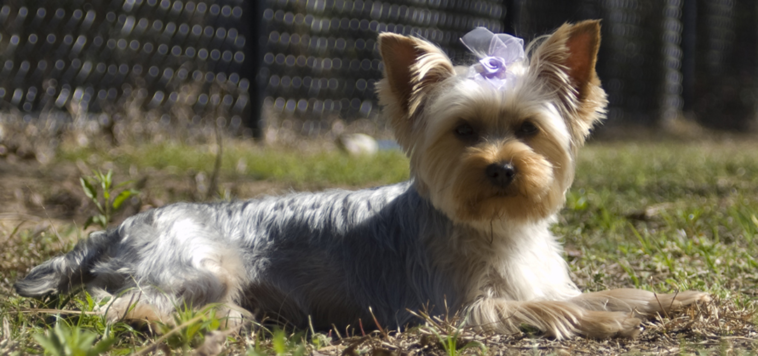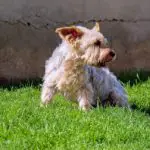When do Yorkies change color? Most Yorkies start changing their coat color by the time they are 6 months old.
However, this change is very slow and you might not even notice it. By the time your pet is 1 to 2 years of age, its permanent coat color would have set in.
Yorkshire terrier breed has unique coat coloring – mostly tan and black but you might also find other beautiful shades like blue-gold, or black-and gold in this gorgeous breed.
In this guide, we will read about:
- When do Yorkies change color? Characteristics of Yorkie puppy coat and adult Yorkie coat
- What causes these coat color changes
- How can you take care of your Yorkie’s gorgeous coat?
- FAQs
Also Read: When Do Yorkies Stop Teething
When Do Yorkies Change Color?
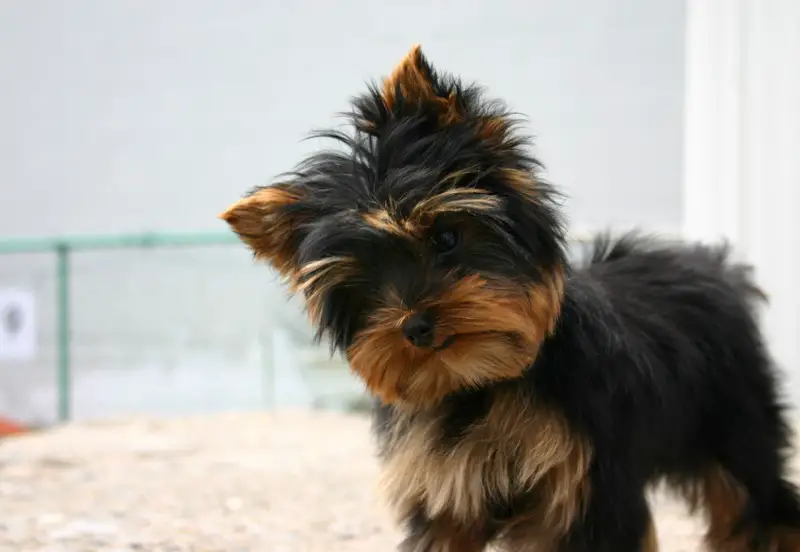
1. Yorkie puppy coat color
Almost all Yorkies have black and tan coats when they are puppies.
The quantities of black and tan fur will vary from puppy to puppy: some pups have more black than tan whiles others have more brown/tan than black. The tan or brown fur is also usually present over the pet’s eyebrows, ears, and parts of the muzzle, neck, and paws.
The amount of black and tan coloring mainly depends on the pup’s bloodlines as the puppy will either take after its dam or father.
2. It’s all in the genes
Yorkshire terrier breed has a unique gene that causes their coats to change to greyish or bluish shade after maturity. Their coat coloring usually starts to change by the time the puppy is around 6 months of age.
However, this change is very slow and you might not even notice it.
By the time your pet is 1 to 2 years of age, its permanent coat colors would have set in. This coat will be very silky and soft and the color may be bluish, black-and-tan, and even black-gold.
3. Accepted Yorkie colors
(Some Yorkie fanciers are very particular about their puppy’s coloring. Many even refuse to accept fully black puppies. However, it is important to know that even if a puppy is fully black as a newborn, it will still have slight golden or tan hairs under that jet black fur!).
In show dogs, the AKC accepts only those Yorkies with the following coloring:
- Black and Gold
- Blue and Gold
- Blue and Tan
- Black and Tan
What do the different Yorkie colors actually mean
Note also that the blue is not an exact ‘blue’ but is more inky black or bluish-black that looks blue in the light. Similarly, gold is simply a richer, shinier shade of tan coloring.
Yorkies do not shed as much as the other dog breeds. However, like human hair, their hair also undergoes a period of growth, change, and fall.
This means that a 4 year old adult Yorkie will not have the same coat it had as a 4 month old puppy.
That is also why you won’t notice dog fur all over your furniture and clothes as you’d with other breeds.
Also, as your puppy transitions to adulthood, its coat might show all four colors: bluish-grey, brown or tan, gold, and black.
You might see the black hair being replaced with bluish-grey and the tan or brown hairs being replaced with gold.
It does not mean that the individual hair is changing color but that the new hair is growing out.
By the time your pet is about 6 months of age, you might start seeing the classic golden fur over its paws.
And by the time of its first birthday, you might notice steel bluish coat with darker brown/tan hair at the roots and golden/light colored tips.
What Causes Coat Color Changes in Yorkies? Top 10 Reasons!
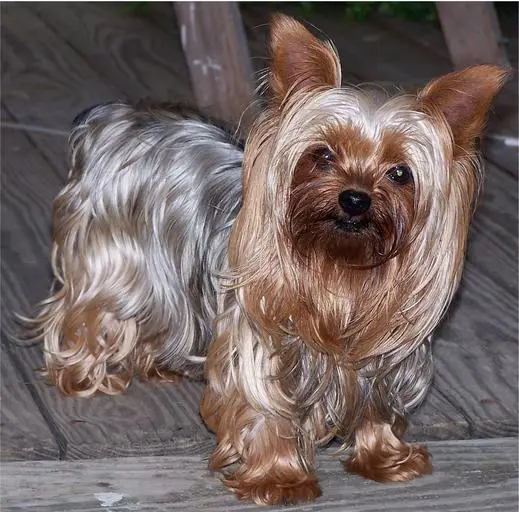
In many dog breeds, coat color changes are very common. They are even a natural process or a rite of passage.
Puppies usually start with one color and change to a completely different color at adulthood.
Here are some reasons why the coat colors may change in dogs:
1. Special Gene
Our Yorkies are special dogs and they have a special gene which results in reduced production of eumelanin pigment.
The eumelanin pigment is responsible for the characteristic black and tan coloring in these special dogs.
As a Yorkie ages, the genetic effect can get more pronounced in some dogs causing lighter or bluish colored fur.
2. Natural Aging
Just as in humans where natural aging causes hair and skin color changes, dogs undergo fur and skin color changes due to aging too.
Of course, your Yorkie might not develop white hair around its eyes and muzzle like other dog breeds, but it will definitely change its characteristic black and tan coloring to more of a bluish, greyish color.
This is due to loss of pigmentation which results from aging. As long as your pet is otherwise healthy and eating and playing normally, you need not worry about its coat color change.
Just make sure you groom your pet regularly to keep an eye out for blisters, smells, pus, and other skin-related issues.
Also Read: Best Brush for Yorkies
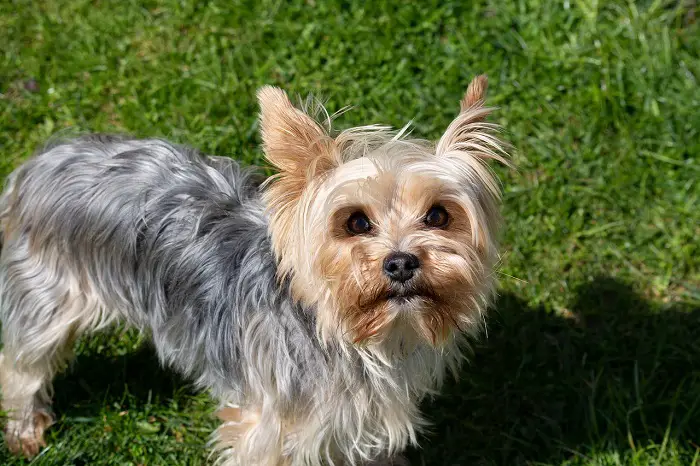
3. Summer Time Skin and Coat Changes
Another factor behind skin and coat color changes in Yorkies is the summer time ‘bleaching’ caused by the UV rays of the sun.
Just as humans tan when their skin is exposed to the sun for long, even dogs’ skin can change colors.
However, in dogs, the skin and hair tends to turn lighter, as opposed to darker. This may also be a factor as to why the tan fur changes to a golden hue in Yorkies.
It is best to minimize your Yorkie’s exposure to the sun since this delicate breed is prone to heat strokes and heat exhaustion.
Also Read: What Do Yorkies Usually Die From
4. Shaving and Hair Trimming
Frequent hair trimming and shaving from the roots can also cause fur color changes in Yorkies.
Most Yorkie parents do not shave their Yorkies as they rarely shed and their silky coat simply needs plenty of brushing to prevent mats and tangles.
However, in general, frequent haircuts could cause lighter colored fur in many dogs, including our Yorkies.
This may be because clipping the hair alters the length which, in turn, could alter the texture and resultantly the amount of light reflected back by the hair.
(That is why, many groomers warn pet parents about possible coat color changes post grooming).
5. Injuries and Skin Conditions
In neglected Yorkies, or those with traumatic skin conditions or injuries, the amount of melanin produced could be impacted.
This, in turn, can result in lighter fur.
The converse is also true sometimes. In some dogs, there may be damage to the hair follicles which caused the melanin pigment to rush to the injured area. This could result in darker colored fur.
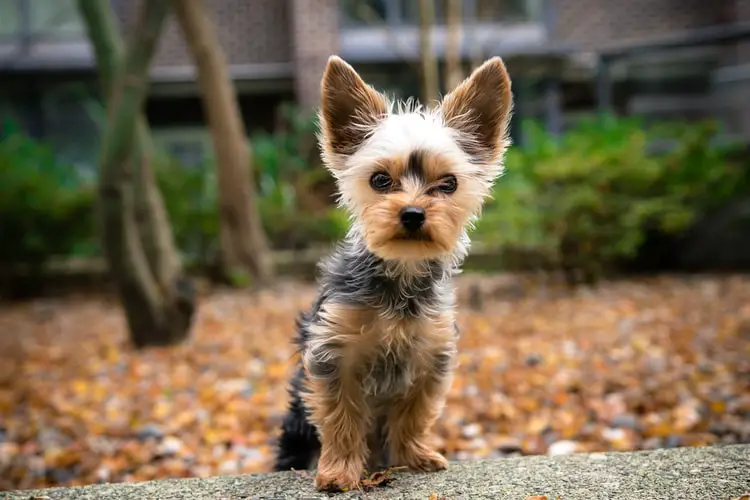
6. Hormonal Changes
Hormonal issues like thyroid related problems – under or overactive thyroid – could also result in coat changes caused by different levels of pigmentation.
Of course, this type of color change isn’t normal and you must have your pet treated for the issue.
Thyroid-related problems can also cause coarse or brittle hair texture, hair loss, and weight changes in Yorkies.
7. Tear Stains and Facial Fur Color Changes
Some Yorkies could suffer from tear stains which can cause reddish-brown stains under their eyes.
These stains are a result of porphyrins which are iron-rich compounds secreted by your pet’s eye discharge or tears.
They can stain the fur underneath the eyes brown and your pet will need careful grooming to restore the original fur color.
Also Read: Best Dog Food for Tear Stains
Also Read: How to Remove Dog Eye Boogers
8. Constant Licking and Paw Fur Color Changes
Constant licking of paws can also result in reddish brown fur in the paws and other areas.
You might want to change your Yorkie’s diet as certain food allergies may be causing the excess paw licking.
Also Read: Best Dog Food for Yorkies with Allergies
9.Stress and Anxiety
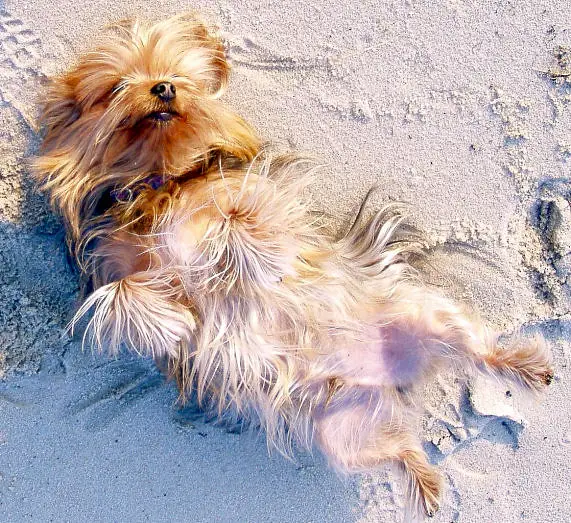
Stress and anxiety can also cause a Yorkie’s hair to turn white or lighter than normal.
Stress results in hormonal changes which, in turn, can impact the pigment production that is responsible for the tan and black coloring in Yorkies.
If your Yorkie is also showing other signs of stress, have it examined by a vet. You must also make environmental changes to reduce this stress.
10. Heredity
Heredity and genetics can also play a huge role in how the coat changes in your Yorkshire terrier.
If you have met your Yorkie’s parents, chances are that it will take after either of them. This can give you an idea of its hair color at that age.
So, if your Yorkie’s parents had bluish color or more golden fur, then you could expect the same in your Yorkie.
How to Take Care of a Yorkshire Terrier’s Gorgeous Coat?
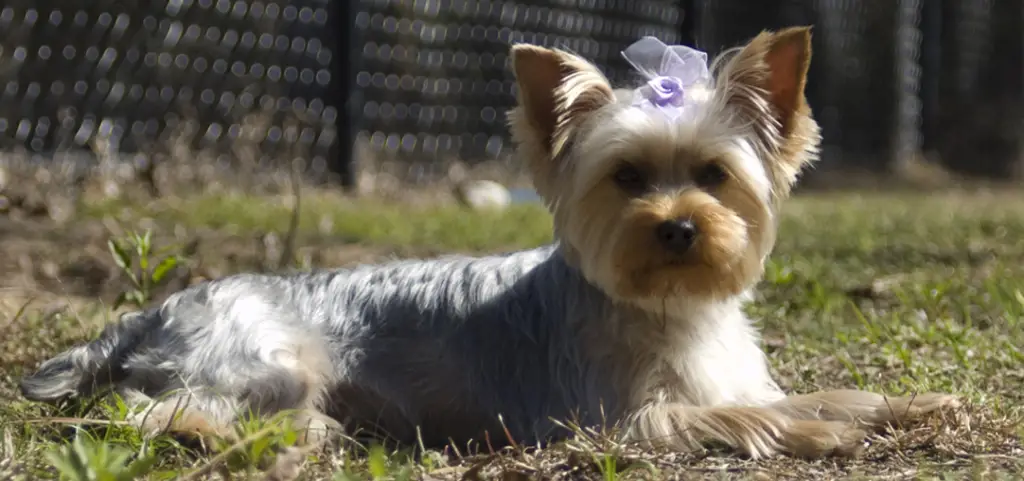
A question most commonly asked by Yorkie parents is ‘how do I keep my Yorkie’s coat soft, shiny, silky and smooth?’
Here are some effective tips for coat maintenance in the Yorkshire terrier:
1. Healthy Diet, Healthy Coat
Your Yorkie’s coat and skin condition greatly depends on its overall health.
So, the key to a shiny, soft, and silky coat is a balanced diet that is rich in Omegas.
Feed your pet a high-quality dog food or homemade food. Ensure that it gets plenty of protein, antioxidants, and healthy fats.
You can also add a teaspoon of coconut oil to your pet’s food.
Also read: Best Dog Food for Yorkie
2. Regular Exercise
You might not think much about it, but a well-exercised dog always has a better coat.
So exercise your Yorkie daily by taking it out on walks. You could also try swimming with your Yorkie.
Check Out our Guide on Do Yorkies Like to Swim?
3. Brush and Brush Some More
Regular brushing is a must to prevent mats and tangles in your Yorkie’s fur.
Brushing also distributes the natural skin oils throughout the fur to prevent issues like dryness, scabbing, and dandruff.
For long-haired and silky-coated dogs like Yorkies, you need to use a No products found. .
Use the brush all over your pet’s fur daily to minimize tangling and matting and also redistribute the natural skin oils.
4. Aloe Vera
While you must bathe your Yorkie once a month, you can apply some aloe gel all over its coat in between baths.
Aloe will moisturize the coat and prevent dryness, dandruff, and scabbing. It will also soothe irritated skin areas, if any, and prevent odors, bacterial/yeast infections.
5. Avoid Over-bathing
It can be tempting to bathe our dogs every time they start smelling off.
However, over-bathing can do more harm than good and could even strip the natural oils. This can end up giving a dull, dry appearance to your Yorkie’s otherwise gorgeous coat.
So, avoid bathing more than once a month unless your pet spends a lot of time outdoors in the mud.
FAQs on Why Do Yorkies Change Color?
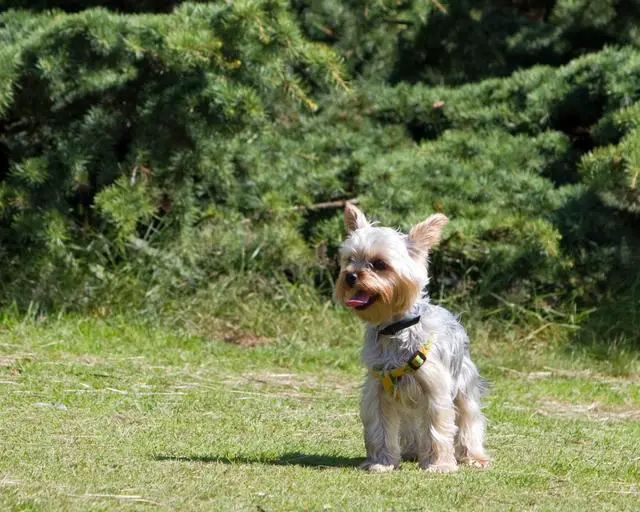
1. Why do Yorkies change coat color? Is it normal?
Yes, coat color changes are normal in Yorkies. An adult Yorkie will have more gold or bluish coloring than tan and black that is characteristic of Yorkie puppies.
In short: an adult Yorkie is more likely to be lighter in color than it was in puppyhood. These dogs have a special gene that reduces the eumelanin pigment which is responsible for the black-and-tan coloring.
2. How do I know if my Yorkie is pure-breed or full-blooded?
A pure-bred Yorkie puppy from healthy and pure-blood parents is likely to have a black and tan coloring.
You might even see a Yorkie puppy with jet black hair but it will still have some tan or gold underneath all that black.
Make sure you purchase your Yorkie puppy from a reputed breeder only. This way, you will be assured of having a full-blooded puppy with parents registered with the AKC.
3. Are white Yorkies rare?

White is a rare color in Yorkies and it may be the Biewer Yorkshire terrier that you might have seen.
The Biewer Yorkie is mostly white in color but may also be available in black-white, blue-white, or only black or blue color.
The Yorkie, on the other hand, is usually seen only in black-tan, blue-gold, blue-tan, and black-gold colors. White color coat is a disqualification for Yorkshire terriers in show rings.
4. Are golden Yorkies rare?
Yes, pure golden Yorkies are very rare as breeders are attempting to prevent solid-colored Yorkies. Even show rings need these dogs to have their hallmark black and tan coloring only.
Conclusion – When Do Yorkies Change Color
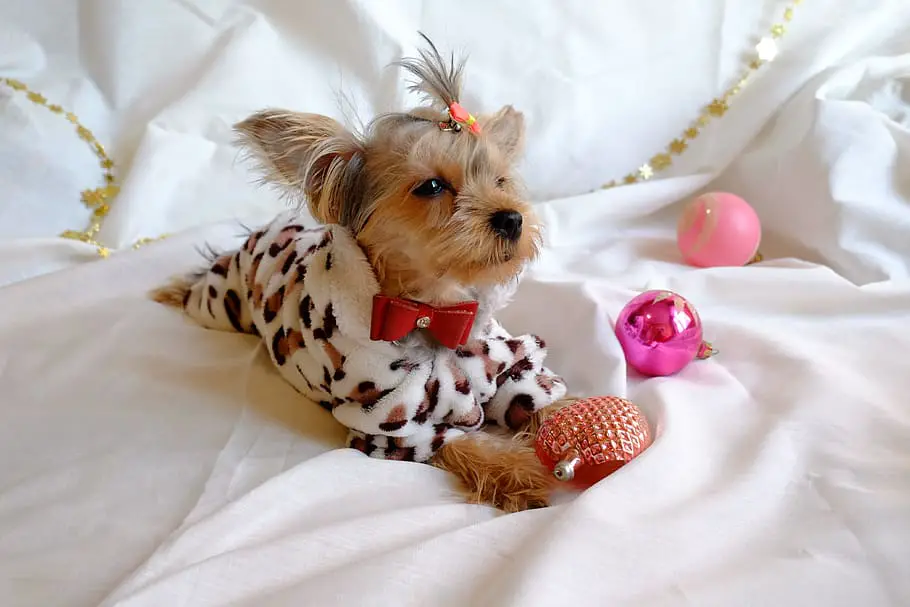
When do Yorkies change color?
Yorkies change their color gradually starting at the age of around 6 months. This is when you might start seeing their paws turn to their trademark golden hue.
By its first birthday, its adult coloring would have set in: typically it would be black and tan, black and gold, or bluish tan or gold.
We hope this guide helps you answer the question: When do Yorkies change color?
